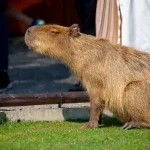

Capybaras don’t have a strong odor like some pets. But they do have a scent gland, located on their nose and sometimes on their back. The capybara’s scent gland is used for marking and communication. When relaxed and clean, they usually don’t smell. In groups, especially if space is limited, a slight musky scent may be noticeable, but it’s not unpleasant.
Capybara pet mostly active during the early morning and late afternoon. In quiet, low-traffic areas, they stick to this natural rhythm. However, in places where people or predators are present, they adapt and become more active at night. So yes, in some situations, capybaras are nocturnal by choice, not by nature.
How much do capybaras sleep? On average, they rest for 12 hours a day, often in short naps rather than one long stretch. While it might seem like capybaras sleep a lot, they’re alert in their own calm way. Capybara sleeping habits vary depending on the environment. They often rest near water or under shaded trees, sometimes even dozing off while half-submerged.
These animals are known for being calm and patient. But are capybaras aggressive at all? Not usually. Aggression is rare and usually only happens between males during mating season or over food. In a well-kept setting, aggression is almost never a problem. A giant capybara pet raised with care is more likely to seek out scratches than start a squabble.
Capybaras love water. They are natural swimmers and often spend hours submerged to cool down or feel safe. Capybaras underwater use their eyes, nose, and ears (all located high on the head) to stay alert while floating. They can even hold their breath for up to five minutes. If you ever spot one with just its head above water, that’s normal and part of their daily routine.
This is one of the most common questions from new owners. Can you potty train a capybara? Somewhat. They can learn to use an outdoor spot or a shallow tray, especially if trained early. However, don’t expect perfect results. Like rabbits or guinea pigs, they have habits, not rules. Patience and consistency help, but this is not a pet for spotless floors.
Despite their relaxed image, capybaras can move quickly when needed. So, how fast do capybaras run? Up to 22 miles per hour over short distances. That’s close to a human sprint. Their speed helps them escape threats in the wild and get to water fast. Watching a capybara shift from chill to a quick dash is surprising and impressive.
The natural food capybara enjoys includes grass, aquatic plants, and fruit. In homes or rescues, they also enjoy hay, leafy greens, and safe vegetables. Chewing is key. Their teeth never stop growing, so they need rough food to help wear them down. Occasional treats like melon or carrot are okay, but their diet must stay mostly green and simple.
If you’ve seen photos labeled capybara black and white, chances are you saw edited images or rare lighting. Capybaras typically have reddish-brown to grey fur. Some may appear darker when wet or in shade, but there are no true black or white breeds. Their unique look still offers plenty of charm without needing rare colors.
Need Help!
Interesting Posts






This website gave me everything I needed as a new Capybara owner, reliable care tips, bonding advice, and diet info. Truly a trusted, helpful resource!
Capybara Owner in Oregon
Capybara Pet
Follow Capybarapet.info for trusted information, care guides, and community support centered around these amazing little marsupials.
Quick Links
Categories
All rights reserved | Capybara Pet ©2025